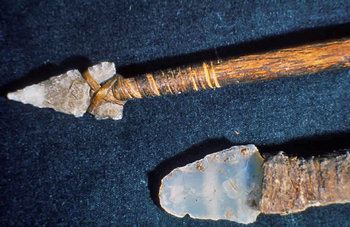Spear
|
|

A spear is an ancient weapon, used for hunting and war. It consists of a shaft, usually of wood, with a sharpened head. The head may be simply the sharpened end of the shaft itself, as is the case with bamboo spears, or it may be of another material fastened to the shaft. The most common design is of a metal spearhead, shaped somewhat like a dagger, and made entirely for thrusting.
The spear is far and away the most common type of pole weapon, and may be seen as the ancestor of such weapons as the lance, the halberd, the naginata and the pike. Also a bayonet mounted on a rifle forms a type of spear. Spears used for close combat require different designs than those intended for throwing. One of the most famous throwing spears is the pilum used by the Romans.
| Contents [hide] |
Symbolism
More than a weapon, a spear may be a symbol of power. In the Chinese martial arts community, the Chinese spear (qiāng 槍) is popularly known as the "king of weapons". The Regalia of many European countries include a spear as well as a sword.
Wotan's spear (called Gungnir) is of ashwood, made from the "World-Ash" Yggdrasil, and it may be remarkable that Chiron's wedding-gift to Peleus when he married the nymph Thetis at a wedding attended by all the Olympians, was an ashen spear (although this could be coincidental, as the nature of ashwood with its straight grain made it an ideal choice of wood for a spear). Another spear of religious significance is the Spear of Destiny, an artifact believed by some to have vast mystical powers.
Lance
A difficult distinction in spear history comes when trying to identify a lance. Early spears were often of light construction and made for throwing. While spears can be thrown, to be useful as stabbing weapons they must be stiffer and therefore heavier. In Europe spears eventually became too heavy to throw, either to give a length advantage in pike formations or so that they could be tough enough to be used by cavalry against armored targets. The term lance comes from Latin, and is generally reserved for these longer, heavy spears and their many variations. Thus most who study medieval weaponry will distinguish between a spear (for throwing) and a lance (a kind of spear that was not thrown).
The large size of a certain form of dart has caused it to be informally called a spear in some cases. Confusingly, they are also sometimes referred to as lances, possibly to distinguish them from spears or due to confusion about the meaning of "lanceolate", a common New World style of stone dart point. Using this type of dart requires a casting device known in English as a "spear thrower" but often denoted by borrowed words such as atlatl or woomera.
Spear formation technique
An interesting argument has surfaced regarding the way spears were used. Based on pictorial evidence, it is generally assumed by the mainstream historical community that spears were wielded overarm, being held at head height from the center of the shaft. However, a re-enactionist by the name of Nikolas Lloyd (http://www.staff.ncl.ac.uk/nikolas.lloyd/weapons/spear.html) argues that spears were in fact held under-arm, at about waist height with the bottom end of the spear resting by the elbow. Lloyd contends that this grip offers much greater reach, greater control, the ability to carefully prod at enemy shields without being forced to commit to an attack, and the ability to strike at a wider range of targets, including the legs.
Pictorial and textual evidence supporting this point is scarce, limited to a few descriptions of spearmen "lowering their spears" to a position of readiness rather than raising them. But considering Hoplite combat gear, which protects the legs and allows for freedom of arm movement at waist level, there is some reason to believe that spears were deployed underarm.
Types of spear
Spears that are often considered lances include:
- Aunurgith
- Awl pike
- Barchi
- Boar spear
- Bohemian ear spoon
- Chimbane
- Contus
- Dung
- Falarica
- Footman's lance
- Hasta
- Jousting lance
- Kadji
- Magari yari
- Mon-Gil Mon-Gil
- Ox tongue
- Plancon a picot
- Qiāng (槍)
- Rummh
- Sangu
- Sarissa
- Spontoon
- Sudis
- Su yari
- Taru
- To-ono
- Yari
Some spears that are not usually considered lances:
- Angon
- Assegai
- Ballam
- Bandang
- Bhala
- Bilari
- Budiak
- Cateia
- Chimbane
- Contus
- Do-War
- Egchos
- Enhero
- Fal-feg
- Falarica
- Framea
- Gravo
- Golo
- Granggang
- Hak
- Harpoon
- Hinyan
- Hoko
- Huata
- Irpull
- Ja-Mandehi
- Jaculum
- Jarid
- Javelin
- Jiboru
- Kasita
- Kamayari
- Kan-Shoka
- Kannai
- Kapun
- Kiero
- Kikuki
- Koveh
- Koy-yung
- Koyuan
- Kujolio
- Kuyan
- Laange
- Lance-Ague
- Lama-pe
- Mandehi liguje
- Mahee
- Makrigga
- Makura Yari
- Mkukt
- Mongile
- Mongoli
- Mu-Rongal
- Nage-Yari
- Nandum
- Nerau
- Paralyser
- Patisthanaya
- Pelta
- Pill
- Pillara
- Pilum
- Sang
- Sangkoh
- Sanokat
- Saunion
- Shail
- Shanen kopaton
- Siligis
- Short spear(or common spear)
- Simbilan
- Sinan
- Sligi
- Soliferrum
- Spiculum
- Su Yari
- Sudanese lance
- Tahr Ruan
- Tao
- Tawok
- Telempang
- Tepoztopilli
- Te yari
- Tirrer
- Tjunkuletti
- Tombak
- Tschehouta
- Tumpuling
- Wainian
- Wallunka
- Wi-Valli
- Zagaye
Spear is the original Japanese name of the Pokémon Beedrill.bg:Копие de:Speer et:Oda he:כידון he:חנית ja:槍 nl:Speer pl:Włócznia sl:Kopje fi:Keihäs sv:Spjut
